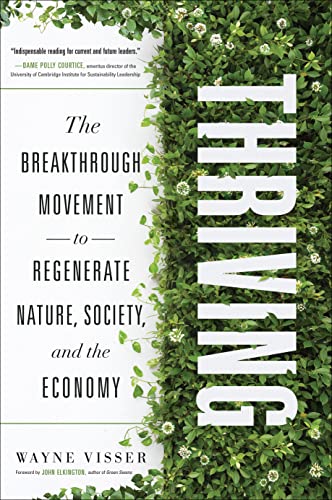Back in 2002, the global shift from degeneration to regeneration was first documented in The Restoration Economy: The Greatest New Growth Frontier.
More recently, the relationship of regeneration to resilience was explored in the 2022 book, RECONOMICS: The Path To Resilient Prosperity.
This regenerative shift is probably the most important subject on the planet, so it can never be repeated too many times.
Now, exactly two decades after The Restoration Economy was published, a new book makes many of the same points, and offers some valuable new perspectives. It’s titled Thriving: The Breakthrough Movement to Regenerate Nature, Society, and the Economy (Fast Company Press, 2022).
Here’s how the author of Thriving, Dr. Wayne Visser, describes the six transitions:
If we are to avoid system-wide breakdowns in nature, society and the economy, we need to make six great transitions to thriving. These go beyond the band-aid responses to our global environmental, social and economic challenges that have been so typical of the sustainability agenda over the past 30 years.
To be sure, progress has been made, yet the entangled problems of climate change, economic inequality, biodiversity loss and social injustice have been getting worse, not better.
The six great transitions emerge from backcasting (as opposed to forecasting): asking, what does a future in which we can thrive look like? When we put it that way, the answer seems obvious. We want a future in which we can feel secure in face of crises, where technology connects us in smart ways, where we feel healthy and satisfied, where economic opportunities are fairly shared, where natural resources are used in sustainable ways, and where ecosystems continue to be symbiotic (mutually beneficial).
Looking at where we are now, compared with where we want to be, we are able to derive six forces of breakdown in nature, society and the economy (I also call these the forces of fragmentation), and for each breakdown, a counterforce of breakthrough (counterforces of integration).
The breakthroughs all lead to, and are enabled by, significant market opportunities. Hence, we see the possibility for business to play a pivotal role in these transitions, through innovation and scaling of solutions. The six transition, which I explore in detail in my book, Thriving, can be summarised briefly as follows.
Transition 1: from degradation to restoration
In the first transition, in nature, we go from degradation of ecosystems due to land-use change and pollution, to restoration of ecosystems through rewilding and regeneration, supported by the ecoservices economy in which we use the markets to invest in natural capital and protect nature.
In this transition, we see nature-based solutions to climate change, regenerative agriculture, ocean farming, expanded nature parks, green walls and roofs, and the growth of ecotourism.
Transition 2: from depletion to renewal
In the second transition, in nature, we go from depletion of natural resources due to overconsumption and waste, to renewal through biological and manufacturing cycles, supported by the circular economy in which we use the markets to invest in renewable energy and closing the loop on resource flows.
In this transition, we see an increase in the use of bio-based and biodegradable materials, recycled content in products, and design for durability, re-use, repair and recycling.
Transition 3: from disparity to responsibility
In the third transition, in society, we go from disparity in workplaces and communities due to inequality and discrimination, to responsibility through diversity and inclusion, supported by the access economy in which we use the markets to invest in economic opportunities for excluded socio-economic groups.
In this transition, we see policies and programs that ensure gender equality, workplace diversity, inclusion of refugees and migrants, support for small businesses, social enterprises and non-profit organisations, and living wages in the supply chain.
Transition 4: from disease to revitalisation
In the fourth transition, in society, we go from human disease due to poverty, harmful workplaces, unhealthy lifestyles and toxic environments, to revitalisation through the promotion of physical and mental health, supported by the wellbeing economy in which we use the markets to invest in disease prevention and access to healthcare.
In this transition, we see a vaccine programs, generic medicines, community-based healthcare, plant-based diets, exercise, mindfulness, meaningful work, and education on disease and burnout prevention.
Transition 5: from disconnection to rewiring
In the fifth transition, in the economy, we go from disconnection from or by technologies due to the digital divide and automation, to rewiring that connects, empowers and regenerates, supported by the digital economy in which we use the markets to invest in innovation to tackle social and environmental challenges.
In this transition, we see the positive use of blockchain, artificial intelligence, big data, digital twins, IoT, 3D printing and other technologies, as well as workforce reskilling to adapt to technology changes.
Transition 6: from disruption to resilience
In the sixth transition, in the economy, we go from disruption of infrastructure and institutions due to climate change, pandemics and other crises, to resilience that ensures social and economic continuity, supported by the risk economy in which we use the markets to invest in our capacity to prevent, adapt to and recover from catastrophes.
In this transition, we see bold climate action, renewable energy, funding for climate adaption and damage, vaccine programs, insurance, disaster relief, emergency response capacity, business continuity planning, sponge cities, and resilient architecture and infrastructure.
These six great transitions towards thriving are all interconnected and have the potential to create breakthrough convergence – due to what the scientists call reinforcing feedback loops. This in turn can bring about positive tipping points: periods of rapid change in which our global society “flips” to a healthier, happier state; one in which we regenerate nature, society and the economy.
But for this to happen, thriving needs to become a social movement in which we all add the momentum of our voices and actions. We are at a bifurcation point, where we must all choose whether to be accelerators of breakdown or breakthrough; agents of decline, or champions of thriving.

